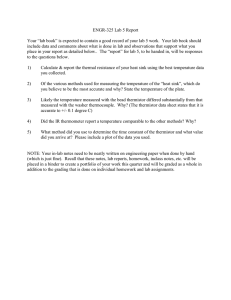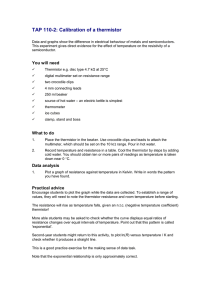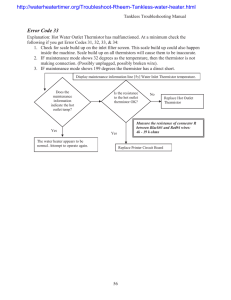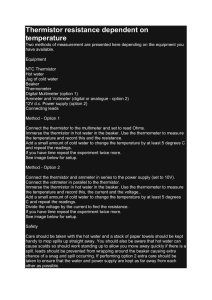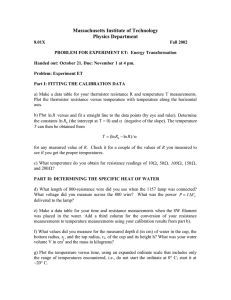Introduction Calibration
advertisement
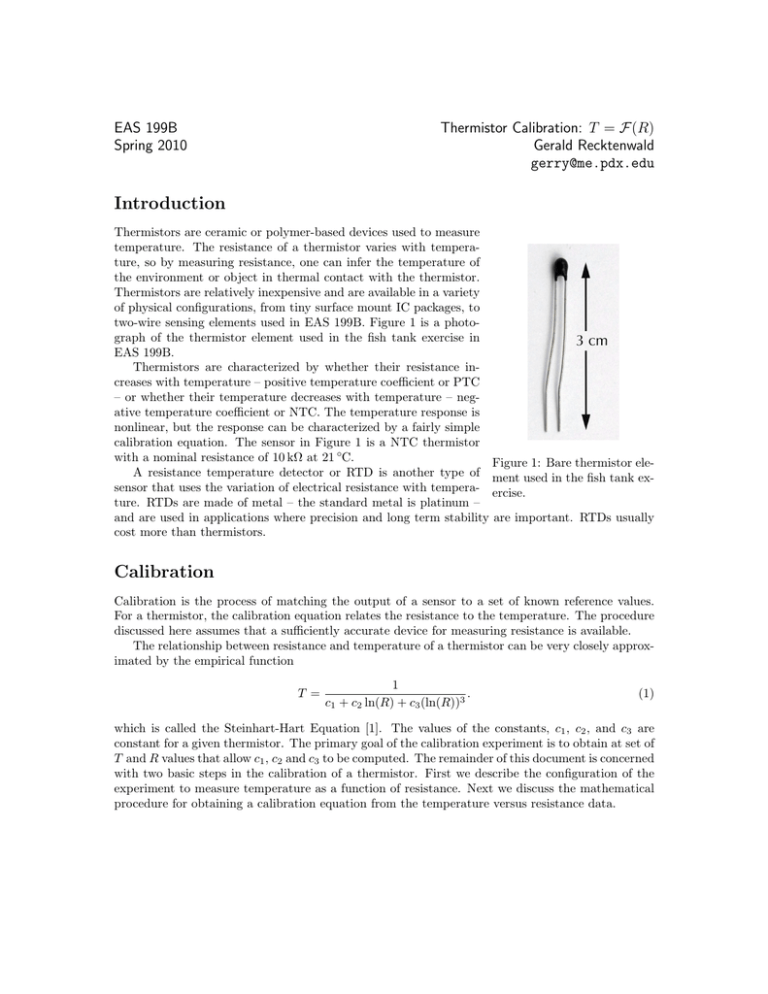
Thermistor Calibration: T = F(R)
Gerald Recktenwald
gerry@me.pdx.edu
EAS 199B
Spring 2010
Introduction
Thermistors are ceramic or polymer-based devices used to measure
temperature. The resistance of a thermistor varies with temperature, so by measuring resistance, one can infer the temperature of
the environment or object in thermal contact with the thermistor.
Thermistors are relatively inexpensive and are available in a variety
of physical configurations, from tiny surface mount IC packages, to
two-wire sensing elements used in EAS 199B. Figure 1 is a photograph of the thermistor element used in the fish tank exercise in
EAS 199B.
Thermistors are characterized by whether their resistance increases with temperature – positive temperature coefficient or PTC
– or whether their temperature decreases with temperature – negative temperature coefficient or NTC. The temperature response is
nonlinear, but the response can be characterized by a fairly simple
calibration equation. The sensor in Figure 1 is a NTC thermistor
with a nominal resistance of 10 kΩ at 21 ◦C.
Figure 1: Bare thermistor eleA resistance temperature detector or RTD is another type of ment used in the fish tank exsensor that uses the variation of electrical resistance with tempera- ercise.
ture. RTDs are made of metal – the standard metal is platinum –
and are used in applications where precision and long term stability are important. RTDs usually
cost more than thermistors.
Calibration
Calibration is the process of matching the output of a sensor to a set of known reference values.
For a thermistor, the calibration equation relates the resistance to the temperature. The procedure
discussed here assumes that a sufficiently accurate device for measuring resistance is available.
The relationship between resistance and temperature of a thermistor can be very closely approximated by the empirical function
T =
1
.
c1 + c2 ln(R) + c3 (ln(R))3
(1)
which is called the Steinhart-Hart Equation [1]. The values of the constants, c1 , c2 , and c3 are
constant for a given thermistor. The primary goal of the calibration experiment is to obtain at set of
T and R values that allow c1 , c2 and c3 to be computed. The remainder of this document is concerned
with two basic steps in the calibration of a thermistor. First we describe the configuration of the
experiment to measure temperature as a function of resistance. Next we discuss the mathematical
procedure for obtaining a calibration equation from the temperature versus resistance data.
EAS 199B :: Thermistor Calibration
Insulated
Coffee mug
2
1.23
Thermistor
probe
Reference
Thermometer
Multimeter
Figure 2: Sketch of hardware used for the thermistor calibration.
Calibration Measurements
Figure 2 is a schematic representation of the equipment used in the calibration measurements. An
insulated coffee mug provides a stable and adjustable temperature environment for the reference
thermometer and the thermistor probe. The thermistor resistance is recorded with a multimeter.
Figure 3 has photos of the reference thermometer and the thermistor probe. The reference
thermometer is a CDN ProAccurate Quick-Read DTQ450X Thermometer, which is available at
on-line stores and kitchen supply stores. The thermistor probe is fabricated from a thermistor
sensing element following the directions at http://web.cecs.pdx.edu/~gerry/class/EAS199B/
howto/thermistorProbe.
Once the equipment is assembled and ready to use, perform the following steps to obtain the
calibration data.
1. Fill the coffee mug with water at a desired temperature.
2. Insert the reference thermometer and the thermistor probe into the water in the mug.
3. Wait for the thermistor probe signal and the reading of the reference temperature to stabilize.
4. Record the temperature and the thermistor resistance. See Table 2 for the recommended
layout of the data table.
5. Return to step 1
Table 1: Equipment required for the thermistor calibration experiment.
Equipment
Thermistor probe
At least one insulated coffee mug per group
Multimeter capable of reading resistance
Spreadsheet or notebook paper for recording measurements
Digital thermometer
Supply of hot and cold water
Provided by
Student
Student
Student
Student
Instructor
Instructor
EAS 199B :: Thermistor Calibration
3
Figure 3: Digital thermometer and thermistor probe used in the calibration.
A source of hot water is provided in the laboratory. If your group has two mugs, you can be
refilling one mug while you wait for the reference thermometer and thermistor probe to come into
equilibrium with the water in the other mug.
Table 2: Calibration data and transformed calibration data.
T (◦C)
1/T (K−1 )
R (Ω)
−→
ln(R)
EAS 199B :: Thermistor Calibration
4
Obtaining the Calibration Equation
Equation 1 is a non-linear relationship between the temperature and resistance of a thermistor.
Figure 4 shows a set of calibration data for a thermistor probe when the resistance is recorded by
a multimeter. The calibration data in Figure 4 reveal several important features
• The temperature decreases non-linearly with resistance. This is an NTC thermistor.
• The Steinhart-Hart equation does a good job of fitting the data
• The polynomial does a poor job of fitting the data. Using polynomials of different degree does
not result in a substantially improved polynomial fit.
A direct curve fit with Equation (1) would require a non-linear least squares procedure. Those
procedures exist and are not too difficult to implement, but a simpler procedure can be obtained
with an algebraic rearrangement that begins by inverting both sides of Equation (1)
1
= c1 + c2 ln(R) + c3 (ln(R))3 .
T
(2)
This equation is almost a polynomial of the form T = f (ln(R)). Adding the missing quadratic term
gives
1
= a1 + a2 ln(R) + a3 (ln(R))2 + a4 (ln(R))3 .
(3)
T
Equation 3 is now in the format of a polynomial where the independent variable is ln(R). An
additional transformation is required to obtain good results in the calibration equation. The left
hand side of Equation (3) will take on large values as T → 0. To improve the numerical behavior
of the least squares curve fit, use T in absolute temperature, e.g., kelvin, instead of temperature in
Celsius or Fahrenheit.
70
Data
Degree 3 polynomial
Steinhart−Hart
60
T (°C)
50
40
30
20
10
0
0
5
10
15
Resistance (kΩ)
20
25
Figure 4: Typical calibration data recorded with a multimeter. Raw data is in Appendix A.
EAS 199B :: Thermistor Calibration
5
Procedure for Obtaining the Calibration Equation
The following steps yield a calibration equation for the thermistor.
1. Record the temperature and resistance output in the two columns on the left sided of Table 2.
2. Convert the temperature values to 1/T , where T is on an absolute scale such as kelvin.
3. Convert the R values to ln(R).
4. Obtain the polynomial curve fit to the transformed data. The curve fit coefficients are the
value of the ai in Equation (3).
After the curve fit coefficients are obtained, the calibration equation is evaluated with
T (◦C) =
1
− 273.15
a1 + a2 ln(R) + a3 (ln(R))2 + a4 (ln(R))3
(4)
where T is in kelvin. If the curve fit is obtained in ◦ R, then the constant at then end of Equation (4)
is 459.67, not 237.15.
Inverse Calibration: R = f (T )
In some situations, we may want to predict the thermistor resistance R when the temperature is
known. Let’s call this the inverse calibration. How can we design the curve fit for R = F (T )?
Although Equation (1) or Equation (4) are the desired final forms of the calibration equation,
the least squares curve fit to obtain the coefficients a1 . . . a4 was obtained with the transformation
in Equation (3). Therefore, since a good curve fit to the calibration data is obtained with (1/T ) =
F(ln(R)), it is reasonable to expect that an inverse curve fit can be obtained with ln(R) = G(1/T ).
Experience shows that the inverse relationship can be fit with
2
1
1
ln(R) = b1 + b2
+ b3
.
(5)
T
T
Procedure for Obtaining the Inverse Calibration Equation
The following steps yield a calibration equation for the thermistor.
1. Convert the temperature values to 1/T , where T is on an absolute scale such as kelvin.
2. Convert R to ln(R).
3. Use the least squares procedure to obtain the coefficients b1 , b2 , and b3 in Equation (5).
After the curve fit coefficients are obtained, the inverse calibration equation is evaluated with
"
2 #
1
1
+ b3
.
(6)
R = exp b1 + b2
T
T
where T is absolute temperature.
References
[1] John S. Steinhart and R. Hart, Stanley. Calibration curves for thermistors. Deep-Sea Research,
15:497–503, 1968.
EAS 199B :: Thermistor Calibration
6
Appendix: Sample calibration data
Calibration data for a MF52A103J3470 NTC thermistor with a nominal resistance of 10 kΩ at
21 ◦C. Data recorded 25 May 2010 with a Fluke 77 multimeter and a CDN ProAccurate QuickRead DTQ450X Thermometer.
T(C)
43.40
52.90
5.90
60.70
10.90
45.20
20.20
36.30
26.95
30.95
32.20
22.80
38.70
R(kOhm)
4.99
3.60
21.64
2.77
17.40
4.69
11.90
6.43
9.17
7.87
7.50
10.80
5.89
Appendix: Matlab code for obtaining calibration equations
EAS 199B :: Thermistor Calibration
function thermistorResistanceCalibration(n,ni,datadump)
% thermistorResistanceCalibration Curve fit thermistor calibration data T = f(R)
%
where R is the resistance of the thermistor
%
% Synopsis: thermistorResistanceCalibration
%
thermistorResistanceCalibration(n)
%
thermistorResistanceCalibration(n,ni)
%
thermistorResistanceCalibration(n,ni,datadump)
%
% Input: n = degree of attempted polynomial fit R = f(T), Default: n = 3;
%
ni = degree of polynomial used in the inverse curve fit R = g(T)
%
Default: ni = 2;
%
datadump = flag (true or false) determining whether T = f(R) data
%
is written to a text file. Default: datadump = false
if nargin<1, n=3;
if nargin<2, ni=2;
if nargin<3, datadump=false;
end
end
end
% --- Store data for thermistor 1 and perform the curve fit
%
Data taken at home with Fluke 77 multimeter. R is resistance in Ohm
%
Reference temperature measured with CDN Pro Quick-read digital thermometer
R = [ 4.99 3.60 21.64 2.767 17.40 4.69 11.90 6.43 9.17 7.87 7.50 10.80 5.89]*1000;
T = [43.4 52.9
5.9 60.7
10.9 45.2 20.2 36.3 26.95 30.95 32.2 22.8 38.7];
% --- Save the raw data in a text file
if datadump
fout = fopen(’thermistor_RT_data.txt’,’wt’);
for i=1:length(R)
fprintf(fout,’%f\t%f\n’,R(i),T(i));
end
fclose(fout);
end
f = figure;
set(f,’Name’,’Thermistor Curve Fit’);
c1 = thermistorFit(R(:),T(:),n);
% R(:) and T(:) guarantees that data sent
% to thermistorFit are column vectors
% --- Evaluate the curve fit
Rfit = linspace( min(R), max(R) );
Tfit1 = (1./ (c1(1) + c1(2)*log(Rfit) + c1(3)*(log(Rfit)).^3 ) ) - 273.15;
% --- Plot the curve fit and data on the same axes.
R in kOhm
f = figure; set(f,’Name’,’Thermistor curve fits’);
plot(R/1000,T,’o’,Rfit/1000,Tfit1,’r:’);
xlabel(’Resistance (k\Omega)’); ylabel(’T (^{\circ}C)’);
legend(’Thermistor 1 data’,’SHH fit for thermistor 1’);
% --- Add the nominal (R10,T10) point, where R10 = 10 kOhm
R10 = 10e3;
TR10 = 1./ (c1(1) + c1(2)*log(R10) + c1(3)*(log(R10)).^3 ) - 273.15;
hold(’on’);
plot(R10*[1 1]/1000,[0 TR10],’k:’,[0 R10]/1000,TR10*[1 1],’k:’);
hold(’off’);
% --- Inverse calibration: R = g(T).
g(T) is a polynomial of degree ni
ci = polyfit(1./(T+273.15),log(R),ni);
Tifit = linspace(min(T),max(T));
Rifit = exp( polyval(ci,1./(Tifit+273.15)) );
fprintf(’\nInverse fit coefficients:\n’);
fprintf(’%18.7e’,ci); fprintf(’\n’);
figure(’Name’,’Inverse fit’);
plot(T,R,’o’,Tifit,Rifit,’r--’);
xlabel(’T (C)’); ylabel(’R (k\Omega)’);
legend(’Thermistor 1 data’,’Thermistor 1 fit’);
7
EAS 199B :: Thermistor Calibration
function c = thermistorFit(R,T,n)
% thermistorFit Curve fit the Steinhart-Hart equation and a degree n polynomial
%
to the thermistor data
%
% Synopsis: c = thermistorFit(R,T)
%
c = thermistorFit(R,T,n)
%
% Input: R = column vector of delay times returned by the RCTIME command
%
R is proportional to the resistance of the thermistor
%
T = column vector of temperatures in C (degrees C because the
%
curve fit coeficients will be obtained with T in kelvin
%
n = optional degree of the polynomial used in the alternative fit
%
% Output: c = vector of coefficients in the Steinhart-Hart equation
if nargin<3, n=3;
end
%
Provide defalt value for n
% --- Assemble the m-by-3 design matrix. m rows of data. Each column
%
is a basis function for the fit. The first column is ones, which
%
corresponds the constant in the curve fit.
%
Solve the overdetermined system with the backslash operator, which
%
uses a QR factorization to obtain the least squares fit. The right
%
hand side vector for the overdetermined system is a column of 1/Tk
%
values, where Tk is the temperature in kelvin.
A = [ones(size(R(:))) log(R(:))
(log(R(:))).^3];
TKinv = 1 ./ (T(:) + 273.15);
c = A\TKinv;
fprintf(’Steinhart-Hart coefficients\n’);
fprintf(’%17.9e\n’,c)
% --- Use a polynomial fit T = f(R). Converting the temperature scale
%
to kelvin does not improve the fit.
cp = polyfit(R,T,n);
% --- Evaluate and plot the curve fits over the range of R data
Rfit = linspace(min(R),max(R))’;
Tfit = polyval(cp,Rfit);
TfitSH = 1./ (c(1) + c(2)*log(Rfit) + c(3)*(log(Rfit)).^3 );
plot(R/1000,T,’o’,Rfit/1000,Tfit,’b:’,Rfit/1000,TfitSH-273.15,’k--’);
xlabel(’Resistance (k\Omega)’); ylabel(’T (^{\circ}C)’);
legend(’Data’,sprintf(’Degree %d polynomial’,n),’Steinhart-Hart’);
8
